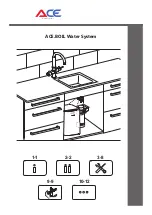
40
WILO SE 03/2016 V06 DIN A4
English
TROUBLESHOOTING AND POSSIBLE SOLUTIONS
A log must be kept of all maintenance and repair
work, which must be signed by the service em-
ployee and the end-user.
NOTE
We recommend concluding a maintenance
contract for regular maintenance work. Please
contact Wilo customer service for more infor-
mation about this.
9. Troubleshooting and possible solutions
In order to prevent damage or serious injury when
repairing malfunctions on the lifting unit, the
following points must always be observed:
• Only attempt to rectify a fault if you have quali-
fied staff. This means that each job must be car-
ried out by trained specialist staff. For example,
electrical work must be performed by a trained
electrician.
• Always secure the lifting unit to prevent it re-
starting inadvertently, by disconnecting it from
the electrical mains. Take appropriate safety
precautions.
• Also comply with the installation and operating
instructions provided with the accessories used!
• Unsanctioned modifications to the lifting unit are
made at the operator's own risk and release the
manufacturer from any warranty obligations!
9.1. Overview of possible malfunctions
Fault
Identifier for cause and
remedy
Lifting unit does not pump
1, 3, 5, 6, 7, 8, 9, 10, 11, 12,
15, 16, 17
Volume flow too low
1, 2, 3, 4, 5, 7, 8, 11, 12, 13
Current consumption too
high
1, 2, 3, 4, 5, 7, 13
Delivery head too small
1, 2, 3, 4, 5, 8, 11, 12, 13, 16
Lifting unit runs roughly /
loud noise
1, 2, 3, 9, 12, 13, 14, 16
9.2. Overview of possible causes and their remedies
1. Inlet or impeller clogged
• Remove deposits from the inlet, reservoir and/
or pump ⇒ Wilo customer service
2. Incorrect direction of rotation
• Exchange 2 phases of the current feed ⇒ Wilo
customer service
3. Wear of inner parts (e.g. impeller, bearing)
• Renew worn parts ⇒ Wilo customer service
4. Operating voltage too low
• Have the mains connection checked ⇒ elec-
trician
5. Running on two phases
• Renew defective fuse ⇒ electrician
• Check the electrical connection ⇒ electrician
6. Motor does not start because there is no voltage
• Check the electrical connection ⇒ electrician
7. Motor winding or electric cable defective
• Have the motor and electrical connection
checked ⇒ Wilo customer service
8. Non-return valve clogged
• Clean non‑return valve ⇒ Wilo customer
service
9. Water level dropped too low in the tank
• Check level control and renew if necessary
⇒ Wilo customer service
10. Defective level control signal transmitter
• Check signal transmitter and renew if necessary
⇒ Wilo customer service
11. Slide valve in the pressure pipe is not or insuffi-
ciently open
• Fully open the slide valve
12. Impermissible amount of air or gas in fluid
• ⇒ Wilo customer service
13. Radial bearing in the motor defective
• ⇒ Wilo customer service
14. Unit-related vibrations
• Check elastic connections of the piping ⇒
notify Wilo customer service if necessary
15. Winding temperature monitoring switched off
due to excessive winding temperature
• The motor switches back on automatically after
the winding has cooled down.
• Frequent switch-off by the winding tempera-
ture monitoring ⇒ Wilo customer service
16. Pump ventilation clogged
• Clean the pump ventilation line ⇒ Wilo cus-
tomer service
17. Electronic motor protection triggered
• Rated current exceeded, reset the motor pro-
tection using the reset button on the switch-
gear
• Frequent switch-off by the electronic motor
protection ⇒ Wilo customer service
9.3. Further steps for troubleshooting
If the points listed here do not rectify the fault,
contact Wilo customer service.
Please note that you may be charged for some
services provided by our customer service! For
more details, please contact Wilo customer
service.
10. Appendix
10.1. Spare parts
Spare parts can be ordered from Wilo customer
service. To avoid return queries and incorrect or-
ders, the serial and/or article number must always
be supplied.
Subject to change without prior notice.



































